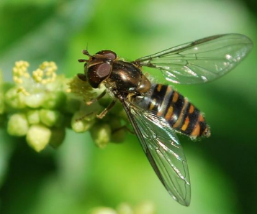Bees have been capturing the nation’s attention, and rightfully so. They are one of the biggest pollinators and therefore are essential to the food we eat, the gardens we grown and maintaining the biodiversity of our ecosystems.
They may sting, but they’re kind of a big deal.
(Photo Credit: Panayiotis Filppou, Flickr)
The 2009 documentary, “Vanishing of the Bees” took a deeper look at the importance of bees in our environment and economy. After prolonged pesticide use and our changing environment bees began to disappear. The European Food Safety Authority (the U.S. EPA’s European counterpart) recently reported that the same pesticides linked to honey bee deaths could also damage the human nervous system.
This report found that two commonly used pesticides – acetamiprid and imidacloprid – can affect the developing nervous system, in particular the brain. Specifically, these chemicals affect the learning and memory sectors of the brain. This report illustrates the imperative need for us to reform our outdated policies on toxic chemicals.
As our friends at the Pesticide Action Network (PAN) said, “It’s well known that neonicotinoids are a key factor in declining bee populations around the world, but today’s announcement from the European Food Safety Authority indicates that there’s also likely cause for concern for human health as well.”
The Negatives of Pesticides
PAN went on to note that the U.S. EPA fast tracked the use of these harmful chemicals and even raised the level of acceptable exposure to infants and children. This is particularly worrisome when reports have raised legitimate concerns about the effects of these chemicals on brain development.
In fact, [pullquote]pesticides are some of the first examples the scientific community had on the dangerous effects chemicals can have on human health and wildlife.[/pullquote] Rachel Carson sounded the alarm with her research on DDT and its effects on wildlife populations. Well-respected pediatrician Dr. Phil Landrigan wrote a hallmark book showing how pesticides can be ingested and harm children’s development and brain function.
By raising alarm bells around pesticides, scientists have since started to look at other chemicals we come into contact with: formaldehyde in our building materials, VOCs in paint, phthalates in ear buds and vinyl flooring, chlorinated tris in couches and much more.
Despite the somewhat daunting research around pesticides, bees and our health, there are other options. The future doesn’t have to look bleak.
Alternatives
Integrated Pest Management (IPM) is a safer alternative to using pesticides whether it be in agriculture or school grounds. Our friends at Toxic Free North Carolina have extensive resources for combating pests without the use of pesticides.
Whether you’re looking to eliminate ants in your kitchen, pests in your garden or pushing for pesticide-free school grounds, check out their list of resources.
Second, the organic market in the United States continues to rise, sales reached $28 million dollars in 2012. According to data from the U.S. Department of Agriculture, the amount of certified organic cropland has seen a steady growth over the last decade as well.
So while the new report showing links between bees, our brains and pesticides is sobering, let’s remember the collective power we have. There are ways we can tackle this problem that involve several important action steps.
Next Steps
We have power as consumers to buy organic food when possible, we can work with our schools and community to reduce and eliminate the use of pesticides in fields and parks, and finally we can tell the EPA we want action on toxic pesticides.
Join the Pesticide Action Network and tell the U.S. EPA that we want leadership and action on protecting bees and our brains from toxic chemicals. http://www.panna.org/issues/related-actions/tell-epa-new-leader-step-protect-bees
Click here to read EFSA’s full report.




